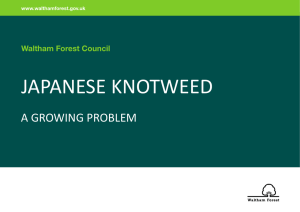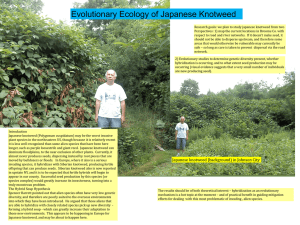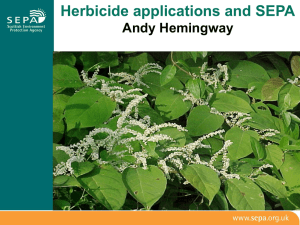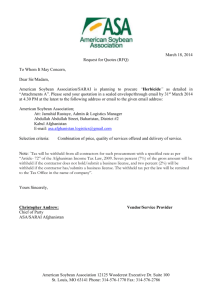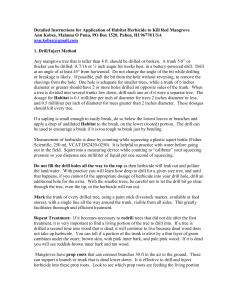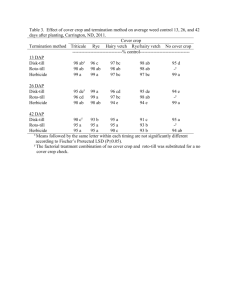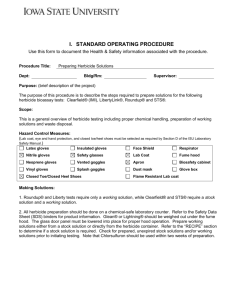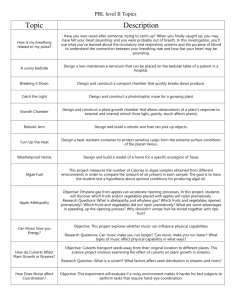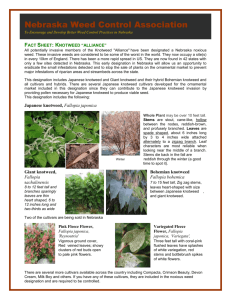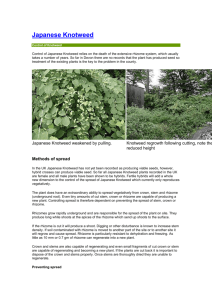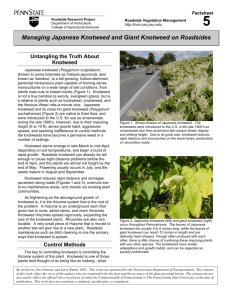Methods of Reynoutria spp. elimination
advertisement
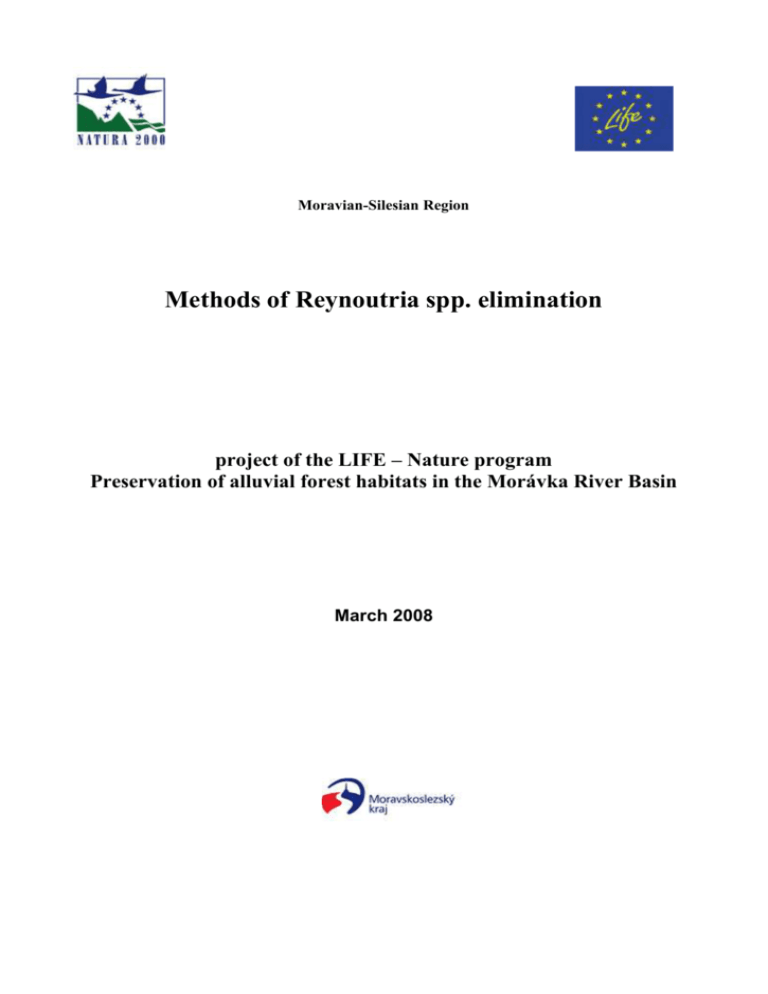
Moravian-Silesian Region Methods of Reynoutria spp. elimination project of the LIFE – Nature program Preservation of alluvial forest habitats in the Morávka River Basin March 2008 1 Conventional methods 1.1 Application of herbicide by spraying leaves 1.1.1 Application in late summer - spray the area of plant growth with a solution of the herbicide Roundup Biaktiv, concentration 7% (10%)* - application using a spraygun (individual plants) or spray blower (extensive areas) on fullgrown plants (height approximately 1.5 m, see high growth), ensure the entire plant is equally wetted - preferably at the time of budding and flowering (August, September), no later than 10 days before the first frost; in special cases, application may already be started at the end of May (at the cost of lower efficiency) - 14-28 days after the first application, check the treatment area and treat plants which have survived, repeating until all growth is destroyed (approximately 2-3 times) - apply with caution and care to the surrounding flora - only under suitable weather conditions (calm winds, no precipitation during treatment and for at least six hours after treatment), cannot be applied after intense precipitation - the anticipated average herbicide consumption is 26 l/ha for four years, which should reduce the knotweed to less than 10% of its original coverage, with consumption varying depending upon the extent of knotweed cover (from 13 to 39 l/ha/4 yrs) - in small specially protected areas, respect the caretaking plan in force to the maximum extent possible (if it speaks to invasive plants) * the concentration used for spraying will be selected depending upon the effectiveness of the previous year's activity High growth should be cut down before the application of herbicide in May-June, with spraying after four to six weeks (July at the earliest) according to the above method. Use only for high growth, in which there is a threat that the growth will be too high during the optimal period for spraying. Extensive areas of growth should be treated (1) by spraying from the edges, returning after 2-3 weeks and completing the spraying of untreated plants or (2) cutting or stamping out (by bending the stems) a path, to enable spraying to be done everywhere; in this case, it is necessary to check the treatment of the cut portions (the walkway) the following year. It is very advantageous to introduce a system for communication between workers by, for example, spray painting the leaves of plants outlining the already treated area (the noise of the machine makes verbal communication impossible). 1.1.2 Year-round application - the first application of herbicide should be done in spring (May, June), when the knotweed is growing, attains a height of less than 1 metre and has foliage - spraying should be repeated after 2 to 3 months, as needed for the reduced area - spray a 7% (10%)* solution of Roundup Biaktiv (year 2007) - application using a spraygun (individual plants) or spray blower (extensive areas) on fullgrown plants (height approximately 1 m), ensure the entire plant is equally wetted - apply with caution and care to the surrounding flora - only under suitable weather conditions (calm winds, no precipitation during treatment and for at least six hours after treatment) - the anticipated average herbicide consumption is 26 l/ha for four years, which should reduce the knotweed to less than 10% of its original coverage, with consumption varying depending upon the extent of knotweed cover (from 13 to 39 l/ha/4 yrs) - in small specially protected areas, respect the caretaking plan in force to the maximum extent possible (if it speaks to invasive plants) * the concentration used for spraying will be selected depending upon the effectiveness of the previous year's activity Notes (concerning both methods) If knotweed seedlings are found in the course of treatment, it is good to dig them up and let them dry out (burn). To make terrain accessible in extremely overgrown areas, it is good to eliminate dry biomass (or at least "stamp it down") before the first application. Advantages: This is likely the most effective method known. Its effectiveness is increased with application in late summer (August, September). Disadvantages: The introduction of foreign substances into the environment, the possibility of an accident, the possibility of herbicide-resistant plants. 1.2 Herbicide application by injection into the stem (injection application) - for injection application, use 20-30% RB herbicide, always about 5 ml (3-7 ml) into the stem, - may be used with stems of at least 1.5 cm diameter (most often 1.5-5 cm in diameter), - apply to the stem at a point low to the ground (below the second or third node) or at a height of 1.3 m above ground, - applied the herbicide to most of the stems in the polycormon, - good for small areas, sensitive areas and low coverage areas - the anticipated average herbicide consumption is 56 l/ha for four years, which should reduce the knotweed to less than 10% of its original coverage, with consumption varying depending upon the extent of knotweed cover (from 28 to 84 l/ha/4 yrs) Note: It's very helpful to secure a special injection pistol (applicator) for this work. Advantages: Although it is a chemical application, it is very environmentally sensitive and minimizes the contaminated area. Disadvantages: In exceptional cases, there may be leaching of the herbicide from the rhizomes in subsequent years. This possibility may be anticipated in cases in which large areas have been treated or there is an exceptionally large amount of precipitation on soils with a small amount of organic material. 1.3 Combined method - the first treatment should be carried out by spraying the herbicide Roundup Biaktiv on the leaves in a 10% concentration, or by injection as described under points 1.1.1 or 1.2. - further treatment in subsequent years should be carried out regularly by cutting 4-8 times per season, as given in point 2.1. 2 Alternative methods 2.1 Cutting - cutting may be carried out with scythe, machete or brush cutters, removing old biomass before beginning to cut if a scythe is used - the first cut should be carried out in the first half of May, before the plant begins to store assimilates in the rhizome, and when growth is not yet fully developed and cutting is therefore easier - something which should always be observed is that the optimal height of the plant for cutting is 40 cm, with cutting best done as close to the earth as possible - the frequency of cutting should be accommodated to growth, always cutting at a height of 40 cm - the number of cuts in the first year may be around 8, with 6/yr in subsequent years - in the May-June period, make 4-6 cuts depending upon the speed of growth, more cuts increase costs and are not reflected in greater effectiveness - after a summer break to allow other plants to flower and seed, make further cuts from the second half of August (always after the plants reach a height of 40 cm) until the end of the season - it's a good idea to plant grass under the knotweed, since it withstands cutting and protects against erosion - let the cut plants dry in small piles, check to see they have not taken root and burn them Advantages: The method is very environmentally sensitive. No foreign substances are used. Disadvantages: Great demands on time, time coordination, three years required before effects appear. Sometimes does not lead to complete eradication, always requires follow-up care for at least 4-7 years. 2.2 Grazing - the optimal animals for grazing are sheep. They prefer ripe leaves, so it is necessary to let them graze for a long period or repeatedly 3-4 times per year - the vegetation should not be allowed to attain a height greater than 150 cm, if this happens, cutting is necessary - 10-20 animals/ha are necessary for year-round grazing, during intensive grazing provide additional food Advantages: The method can be applied without problem near water. No foreign substances are put into the surrounding environment. Certain breeds of sheep even prefer knotweed leaves to grass and other greens. Disadvantages: The movement of animals may lead to erosion of banks and shores. 4-7 years are required for knotweed to disappear. 2.3 Digging - the entire plant is dug up including the rhizome, which may be rooted 25-50 centimetres under the soil surface - must be done several times during the vegetation season, always after growth renews following the foregoing excavation - a good tool for excavation is a digging fork - great care must be taken to prevent transport of the excavated rhizomes, minimize movement - biomass which has been dug up and torn out should be burned in a suitable place - after the autumn digging (the final of the season), the area should be planted with a grass mixture Advantages: This method does not introduce foreign substances into the environment. It may be used in sensitive localities where the use of herbicides is ruled out. Disadvantages: The method requires a careful, responsible approach. There is a threat of knotweed expansion due to rhizomes being transported, so the transport of plant remains must be minimized to prevent them being carried by wind and water. In localities directly proximate to flowing water, there is a threat of increased erosion after digging. 3 Cleaning the area/removing dry biomass - follows the application of the herbicide RB to extensive non-forested areas (especially areas with a high level of old biomass which hinders the recovery of the vegetation floor) - the dry biomass should be cut up and may be burned in a safe place - burning is not necessary if the subsidy entitlement from which the activity is funded does not permit burning 4 Care of the area in subsequent years - plants which renew after treatment ("bonsai knotweed") are treated in the same way, i.e., by spraying (misting) the leaves, preferably during flowering - in exceptionally sensitive (valuable) areas, young growth may be suppressed by regular cutting with a frequency of once every two weeks during the vegetation period - areas from which the majority of knotweed growth has been eliminated must be monitored for several years, so that any further invasion may be suppressed at the outset - it is a good idea to sow the original plant varieties and trees, so that any further invasion is naturally suppressed due to competition for light 5 Comparison of methods Method Spraying herbicide on leaves Injection application of herbicide Combination of herbicide and cutting Cutting Grazing Digging * … low ** … medium *** … high Environmental Effectiveness Time sensitivity of demands liquidation * *** * ** *** *** ** ** ** *** *** ** * * * *** *** ***
